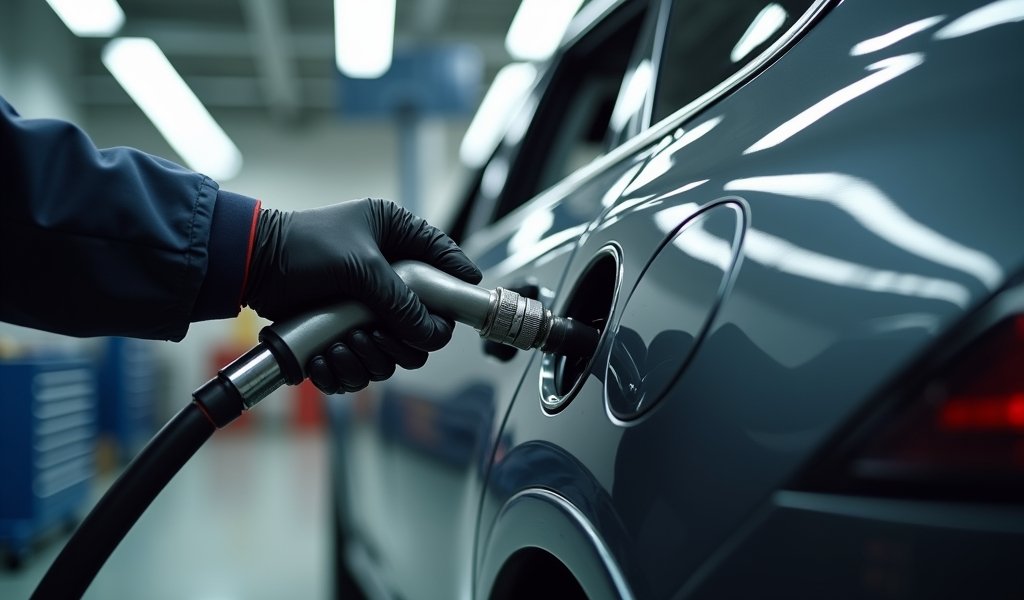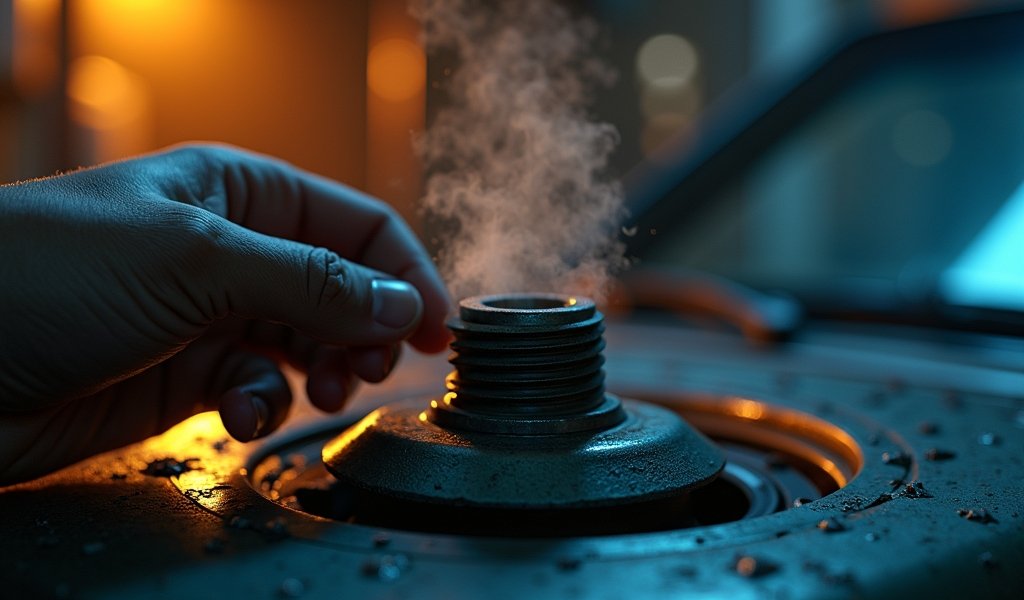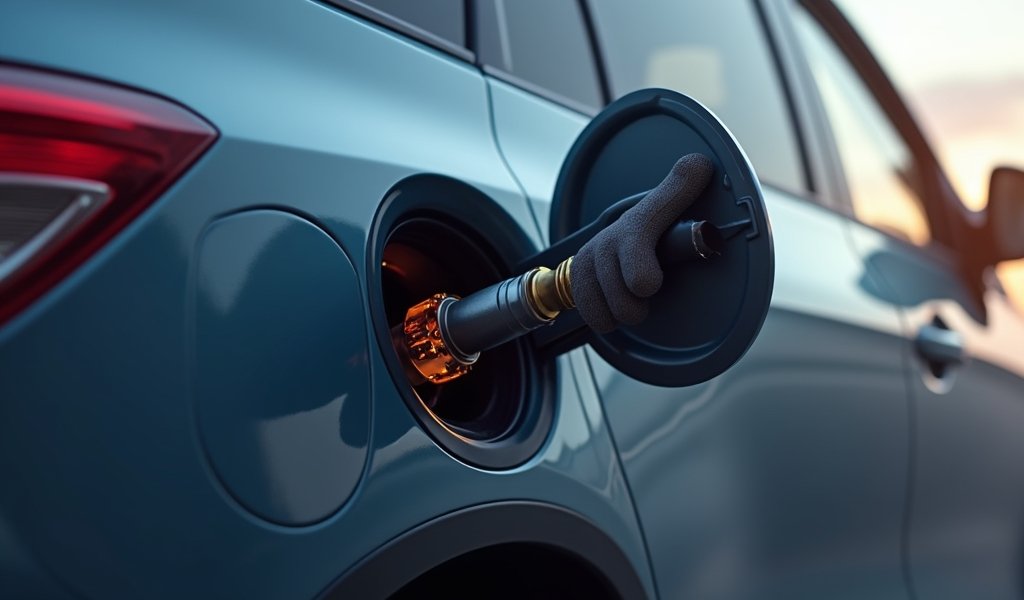Overview
The article provides a step-by-step guide to fixing fuel cap pressure relief valve issues, explaining how this small component affects vehicle performance and fuel economy when malfunctioning. It outlines symptoms of failure (check engine light, decreased fuel efficiency), offers DIY cleaning and replacement instructions that can save $75-150 in repair costs, and includes preventative maintenance tips to extend the valve’s lifespan.
Table of Contents
- Understanding Your Fuel Cap Pressure Relief Valve
- Common Symptoms of a Failing Fuel Cap Valve
- The DIY Fix: Save Money on Repairs
- Step-by-Step Guide to Fixing Your Fuel Cap
- Preventative Maintenance Tips
- Troubleshooting Common Issues
- Conclusion
- Frequently Asked Questions
Understanding Your Fuel Cap Pressure Relief Valve
That little gas cap you twist on during fill-ups is far more important than most drivers realize. It’s not just a cover – it’s a crucial component of your vehicle’s evaporative emission control system. At the heart of this innocent-looking cap sits the pressure relief valve, quietly maintaining the perfect balance of pressure in your fuel system.
Think of this valve as the lungs of your fuel system. It allows your fuel tank to “breathe” when necessary while preventing harmful fuel vapors from escaping into the atmosphere. When pressure builds up in your tank (which happens naturally as fuel warms up), the valve releases just enough to maintain safe levels. When vacuum develops, it allows a controlled amount of air in.
This delicate balancing act happens constantly while you drive, and you’ll never notice it – until something goes wrong. Over time, these valves can become clogged with dirt, debris, or fuel residue. The rubber gaskets that create the seal can dry out, crack, or warp. Even the simple act of twisting it on and off hundreds of times eventually takes its toll.
The good news? Fixing a problematic fuel cap pressure relief valve is often a simple DIY job that can save you a surprising amount of money. Let’s dive into how to identify and fix this common issue before it empties your wallet at the pump or the repair shop.
Common Symptoms of a Failing Fuel Cap Valve
Your vehicle is pretty good at telling you when something’s not right – you just need to know what signs to look for. With a failing fuel cap pressure relief valve, here are the red flags you might encounter:
- Check engine light illumination (particularly with error codes P0440, P0442, or P0455)
- Decreased fuel economy (you’re suddenly filling up more often)
- Difficulty starting the engine, especially after refueling
- A fuel cap that doesn’t “click” properly when tightened
- Gasoline odor around your vehicle
- Failed emissions tests
The check engine light is often the first warning sign for most drivers. Many rush to the mechanic in a panic, only to discover they need a simple fuel cap replacement – at a not-so-simple price. Dealerships often charge $75-150 for diagnosis and replacement, which seems steep for such a straightforward fix.
Don’t ignore these symptoms! Beyond the annoyance of a glowing dashboard light, a faulty fuel cap can cause your vehicle to burn more fuel. According to the Department of Energy, fixing a faulty fuel cap can improve gas mileage by as much as 2% – that adds up over time.
The increased fuel consumption happens because your engine management system detects the pressure imbalance and runs less efficiently while trying to compensate. It’s like trying to breathe through a partially blocked nose – you can do it, but it’s not ideal.

The DIY Fix: Save Money on Repairs
Before you hand over your credit card at the repair shop, let’s talk about how easy this fix can be. With a few basic tools and about 30 minutes of your time, you can often solve this problem for a fraction of what a mechanic would charge.
Here’s what you’ll need to gather before getting started:
- Clean microfiber cloths or soft rags
- Isopropyl alcohol (90% or higher)
- Cotton swabs for reaching tight spaces
- Compressed air (optional but helpful)
- Rubber gloves to protect your hands
- Safety glasses
- New fuel cap (only if cleaning doesn’t resolve the issue)
The total cost? If cleaning solves your problem, you might spend $0. If you need a replacement cap, you’re looking at $10-30 depending on whether you go with an OEM (Original Equipment Manufacturer) or aftermarket option. Compare that to the $75-150 you might spend at a shop, and the DIY approach starts looking pretty attractive.
One important safety note: Always work in a well-ventilated area away from open flames or sparks. Fuel vapors are invisible but highly flammable. Also, make sure your engine is cool before beginning work – no one needs burned fingers on top of car troubles.
Step-by-Step Guide to Fixing Your Fuel Cap
1. Locating and Removing the Fuel Cap
This first step is straightforward – locate your fuel door (typically on the driver’s or passenger’s side of the vehicle) and open it. Turn the fuel cap counterclockwise to remove it. Some vehicles have caps attached by a small tether to prevent loss.
Pay attention to how the cap feels when removing it. A properly functioning cap should have some resistance but shouldn’t require Hulk-like strength to remove. If it feels unusually loose or tight, that’s another clue something might be amiss.
2. Inspection Time
With the cap in hand, it’s time to play detective. The pressure relief valve is typically located in the center of the cap’s underside. Give it a thorough visual inspection, looking for:
- Visible dirt, debris, or fuel residue
- Cracks or damage to the valve mechanism
- Deterioration of the rubber gasket around the edge
- Any signs of warping or melting
A small flashlight can be helpful here – I’ve found smartphone flashlights work perfectly for this task. Good lighting helps reveal issues that might otherwise hide in plain sight.
3. The Cleaning Process
If your inspection reveals only dirt or light residue, a good cleaning may be all that’s needed:
- Dampen a microfiber cloth with isopropyl alcohol and gently wipe away any visible debris from the valve and surrounding areas.
- For harder-to-reach spots, cotton swabs are perfect for detailed cleaning.
- If available, use compressed air to blow out any stubborn debris from the valve mechanism – keep the pressure moderate to avoid damaging the valve.
- Pay special attention to the rubber gasket around the edge of the cap, cleaning it thoroughly but gently.
- Allow everything to air dry completely before reinstallation.
This cleaning process works surprisingly well for caps that are just dirty or gummed up with residue. Many mechanics, myself included, have seen this simple step resolve check engine lights and restore proper function in countless vehicles.
4. Testing Your Work
After cleaning, reinstall the cap, making sure it clicks properly into place. If you have access to an OBD-II scanner, clear any check engine lights (or drop by an auto parts store – many will clear codes for free).
Then drive your vehicle normally for a few days to see if:
- The check engine light remains off
- Fuel economy improves
- Any fuel smell dissipates
In many cases, this simple cleaning is all that’s needed to restore proper function. You’ll know you’ve succeeded when your check engine light stays off and your gas mileage starts to improve.
5. Replacement Options
If cleaning doesn’t solve the problem, it’s time for a replacement. You have three main options:
- OEM Cap: The most expensive option ($15-30) but guaranteed to be an exact match for your vehicle.
- Aftermarket Cap: More affordable ($5-15) and often just as effective, though quality can vary by brand.
- Universal Cap: The budget option (under $10) but may not provide a perfect fit for all vehicles.
I generally recommend going with an OEM or high-quality aftermarket cap from a reputable brand like Gates or Stant. The few extra dollars are worth the peace of mind, especially when the part plays such an important role in your vehicle’s fuel system.
Always check your vehicle’s manual or the manufacturer’s website for the correct specifications. Installing the wrong cap can create new problems instead of solving the original one.
Preventative Maintenance Tips

As with most car problems, prevention is better than cure. Here are some easy ways to extend the life of your fuel cap pressure relief valve:
Regular Inspection
Make it a habit to visually inspect your fuel cap every few months or about every 5,000 miles. This quick glance can catch issues before they trigger warning lights or affect performance. I often recommend doing this during regular oil changes as part of a general vehicle check-up.
Proper Handling
The way you handle your fuel cap can significantly extend its lifespan:
- Always tighten until it clicks (but don’t over-tighten)
- If removing the cap temporarily, place it on a clean surface
- Never place the cap fuel-side down on dirty surfaces
- When replacing, ensure the cap is properly threaded before tightening
These simple habits can prevent contamination and premature wear of the valve mechanism and gasket.
Be Aware of Environmental Factors
Certain conditions can accelerate your fuel cap’s deterioration:
- Extreme heat or cold
- High humidity environments
- Coastal areas with salt air
- Areas with high pollution
- Frequent driving on dirt or gravel roads
If you live in these conditions, inspect your cap more frequently – perhaps every 3,000 miles instead of 5,000. A little extra attention can prevent bigger problems down the road.
Know When to Replace
Even with the best maintenance, fuel caps eventually need replacement. Consider a new cap if:
- The rubber gasket shows significant cracking or deterioration
- The valve mechanism is damaged or stuck
- You notice any warping or melting of the plastic components
- The cap is more than 5-7 years old (preventative replacement)
Many professional mechanics recommend replacing the fuel cap as preventative maintenance every 5-7 years, even if it appears to be functioning properly. This small investment can prevent bigger issues and maintain optimal fuel economy.
Troubleshooting Common Issues
Sometimes, despite your best efforts, issues persist. Let’s address some common scenarios:
Check Engine Light Stays On
If your check engine light persists after cleaning or replacing the cap, don’t panic. The EVAP system may need time to run a complete self-test. Drive normally for about 100 miles. If the light remains on, you may need to:
- Have the codes read again (there might be multiple issues)
- Check other components of the EVAP system
- Make sure the new cap is correctly installed and appropriate for your vehicle model
In some cases, the vehicle’s computer needs to complete several drive cycles before clearing the code, even after the problem is fixed. Patience is key here.
Dealing with Stubborn Debris
For more stubborn situations:
- Try soaking (not submerging) the affected parts in isopropyl alcohol for 10-15 minutes
- Use a soft-bristled brush (like an old toothbrush) for gentle scrubbing
- For corrosion, a specialized automotive electrical contact cleaner might help
Just remember – gentle is the key word here. Aggressive cleaning can damage the delicate valve mechanism.
When to Seek Professional Help
Sometimes, you need to wave the white flag and seek professional assistance. Consider this route if:
- You’ve replaced the cap but check engine lights persist after 100+ miles
- You notice fuel leakage around the filler neck
- Your vehicle fails an emissions test despite having a new cap
- You smell fuel consistently, even with a properly functioning cap
These symptoms might indicate a larger problem with your vehicle’s EVAP system that goes beyond the fuel cap itself. In these cases, diagnostic equipment and professional expertise are worth the investment.
According to research from CarMD’s Vehicle Health Index, EVAP system issues are among the top 10 check engine light repairs, but they’re not always related to the fuel cap alone. Professional diagnosis ensures you’re addressing the real problem.
Conclusion
A properly functioning fuel cap pressure relief valve is something most drivers never think about – until it causes problems. This small component plays a surprisingly important role in your vehicle’s efficiency, emissions, and overall performance.
By taking the DIY approach outlined in this guide, you’ve potentially saved yourself $75-150 in unnecessary service costs. Better yet, you’ve gained valuable knowledge about how your vehicle works and developed skills that will serve you well for future maintenance tasks.
Remember, the key takeaways are simple: inspect regularly, clean gently when needed, replace when necessary, and don’t ignore warning signs. With these habits, you’ll keep your fuel system breathing properly and your wallet a little fuller at the pump.
Car maintenance doesn’t have to be intimidating or expensive. Sometimes the smallest fixes make the biggest difference in your driving experience and your budget. Happy motoring!
Frequently Asked Questions
How much does it cost to replace a fuel cap pressure relief valve?
A replacement fuel cap typically costs between $5-30 depending on whether you choose OEM or aftermarket. Most drivers can install it themselves in seconds, avoiding the $75-150 diagnostic and labor fees at repair shops.
Can a bad fuel cap cause a car not to start?
Yes, in some cases a severely malfunctioning fuel cap can make starting difficult. This happens when the pressure imbalance affects the fuel delivery system or triggers the vehicle’s safety systems.
How tight should a fuel cap be?
Tighten your fuel cap until you hear clicks (usually 3-4 clicks). Overtightening can damage the cap while undertightening won’t create a proper seal.
Will a car pass emissions with a faulty fuel cap?
Most vehicles will fail emissions testing with a faulty fuel cap. The EVAP system is checked during emissions tests, and a leaking cap will trigger failure codes.
Can I drive with a broken fuel cap?
While you can drive short distances, it’s not recommended to drive long-term with a broken fuel cap. You’ll waste fuel, potentially damage your EVAP system, and could fail emissions tests or get fined in certain localities.

